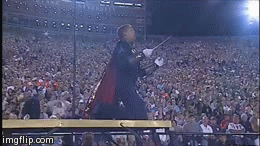What do Shakira and marching technique have in common? Your hips don’t lie! Turnout is one of the most fundamental skills in drum corps, marching band and indoor performance ensembles, and it starts at the hips.
 Turnout involves the legs externally rotating from the hips resulting in out-toeing at the feet. In addition, specific muscle groups assist in rotation and help performers sustain turnout. The external rotators, a set of six small muscles found beneath the gluteus maximus, help to laterally rotate the femur.
Turnout involves the legs externally rotating from the hips resulting in out-toeing at the feet. In addition, specific muscle groups assist in rotation and help performers sustain turnout. The external rotators, a set of six small muscles found beneath the gluteus maximus, help to laterally rotate the femur.
In movement, the generally recognized ideal turnout is 180° (90° from each hip) due to aesthetic appeal and the freedom of movement afforded with a turned-out leg. Realistically, few dancers can achieve this without compensations elsewhere in the body. These compensatory patterns may place increased stress on the involved joints and cause injury.
Common abnormal compensations to look out for:
 1. Increased lumbar lordosis (lower spinal extension)
1. Increased lumbar lordosis (lower spinal extension)
Anteriorly tilting the pelvis will allow for greater external rotation at the hips (see above). However, hyperlordotic posture can predispose a performer to low back pain.
2. “Screwing the knee”
Sometimes performers will assume a half squat position, place their feet in 180° of turnout, and then forcefully straighten their knees without moving the feet. This shear force can put tremendous stress on the knee and damage the medial supportive structures.
 3. Pronation of the feet
3. Pronation of the feet
Forced rolling in of the feet places excessive demands on the extrinsic muscles of the foot to help stabilize the arch. This may predispose the performer to injuries such as shin splints or plantar fasciitis.
Reasons for these compensations could be due to lack of rotational flexibility and the strength to properly hold that rotation. This can be frustrating for many performers because hardly anyone can achieve 180 degrees of rotation. The good news is that it is possible to both improve your turnout and perform at a high level with less-than-perfect rotation. Here are four exercises you can begin to do to safely and effectively improve your turnout.
Stretching:
1. Internal rotation stretch
The performer lies on their back with both knees bent keeping their left knee pointing up to the ceiling. Drop the right knee inward and toward the floor. The right knee should point toward your left leg. Hold your knee down for a slow, 30 seconds. Repeat with the other leg.
2. Adductor stretch (above)
The performer sits up tall with the soles of their feet together and knees fall to the side as far as they will comfortably go. Pull abdominals gently inward and lean forward from hips. Grasping feet with hands, carefully pull farther forward. Increase the stretch by carefully pressing thighs toward the floor.
Strengthening:
1. Side-lying Hip External Rotation
The performer lies on their side with top leg elevated to keep the pelvis level. Bottom leg is straight and lined up underneath the torso. The knee is then flexed to 90 degrees. The performer will fire the 6 deep external rotators and slowly turnout the thigh.
2. Standing External Rotation
The performer begins by standing on 1 leg with hips level. From this position, they will rotation their pelvis away from the leg they are standing on as far as possible. Hold this position for 10 seconds, then return to starting position. Repeat on other side.
REFERENCES:
Cimelli SN, Curran SA. Influence of turnout on foot posture and its relationship to overuse musculoskeletal injury in professional contemporary dancers: a preliminary investigation. J Am Podiatr Med Assoc. 2012;102(1):25-33.
Sherman AJ, Mayall E, Tasker SL. Can a prescribed turnout conditioning program reduce the differential between passive and active turnout in pre-professional dancers? J Dance Med Sci. 2014;18(4):159-168. doi:10.12678/1089-313X.18.4.159.
Washington I, Mayes S, Ganderton C, Pizzari T. Differentials in Turnout Among Professional Classical Ballet Dancers. Med Probl Perform Art. 2016;31(3):160-165. doi:10.21091/mppa.2016.3029.
Hyperpronation in Dancers Incidence and Relation to Calcaneal Angle. – PubMed – NCBI. https://www.ncbi.nlm.nih.gov/pubmed/26730941. Deep six lateral rotators attachments and actions. https://www.yoganatomy.com/deep-six-lateral-rotators/. Accessed June 20, 2017.
All pictures not cited taken by Annie Keener, PT, DPT, OCS, CSCS at Sports Therapy and Rehabilitation in Washington, DC

